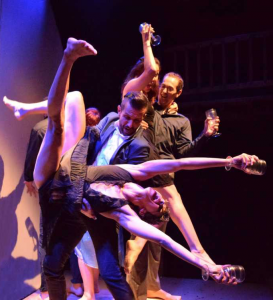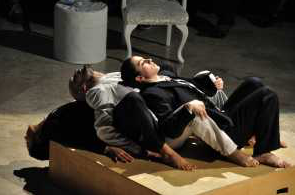“4×4 TJ Night” Kicks Off WOW

Lux Boreal. Photo: Harold Garcia
When the Tijuana dance company Lux Boreal made Dance Magazine’s 25 to Watch in 2008, I wrote that they were raising the bar for dance in Tijuana. And, whether or not it’s Lux Boreal’s influence (I suspect it is), the six mostly-from-Baja works in “4×4 TJ Night,” curated by the company, were super, the best of them showing complexity and wit, as well as serious technical chops.
The show was the kickoff for seven Without Walls (WOW) Festival shows taking place at Bread & Salt, a former bakery turned experimental performance space in Logan Heights. The biennial WOW festival is presented by La Jolla Playhouse, and this—the third—time around, they’re using mostly downtown locations.
“4×4” refers to a 4×4-foot wooden platform, about a foot high, on which the dancers perform. Occasionally, they use the surrounding space, but for the most part, two or three or four dancers crowd onto that tiny stage.
Make that six dancers, in the delicious “La Última y Nos Vamos” (the last one and we go) by Lux Boreal. Choreographed by company founder Henry Torres, the piece opens with two women in sparkly cocktail dresses, miming conversation as club music plays. They’re joined by one man, then another. Everyone holds a cocktail glass, someone “pours” generously from a bottle, and as they mingle, their laughter gets louder and their movements sloppier.
By the time six people have squeezed onto the platform, they’re loosey-goosey … and a marvel of timing and control. Bodies slither past one another. There are exuberant lifts. A woman lies stuporous on the floor, and everyone walks over her. One dancer crashes into four others, who tip from the edge of the platform … but don’t fall. I’ve felt in the past that Lux Boreal’s dancers do ensemble work as if they’re a single organism, and this cast (Pamela Macías, Victorias Reyes, Raúl Navarro, Angel Arambula, Azalea López, and Matthew Armstrong) was no exception.
Lux Boreal debuted “La Ultima … ” at the 4×4 series originated by Liam Clancy and put on by Sushi (San Diego’s legendary edgy presenter from 1980 until its demise in 2011) at a North Park bar. And, as Torres, the show’s light-hearted emcee, acknowledged, Lux Boreal took Clancy’s idea and ran with it. They’ve been staging 4×4’s in Tijuana as competitions, and their WOW show features award-winners from previous years.
Particularly strong were “Jouer” and “Lost in Translation.”

“Jouer”
In “Jouer,” by Daniel Rodriguez, three dancers in business suits (a man and two women) seem to be at war with their own bodies. One arm shoots out to the side, the other hand grabs as if trying to restrain it. There are jerky gestures as the man reads from a lyrical, enigmatic text (from Paul Auster’s “Winter Journal”): “Your scars … are letters from the secret alphabet that tells the story of who you are.” Tense and taut, “Jouer” is performed with beautiful discipline by Carla Alcántara, Dania Barragan and Andrés Garcia.
Rosa Rodriguez and Joey Navarrete both choreographed and perform the quick, comic “Lost in Translation.” Jumping between Spanish (usually her) and English (usually him), they talk through the dance they’re making, sometimes exclaiming, “Beautiful,” but often disagreeing, for instance, when she strikes a “ta da” pose and he shakes his head. And he wants to jump, and tells her that’s his solo move. As they “figure out” moves—with clarity and power—they stay on the platform with split-second pacing. (Rodriguez and Navarrete, from Riverside, are the only non-Baja artists on the program.)
In “Hollki,” it’s fun to see by Maribel Durazo, of La Silla Danza Contemporánea, challenge the limits of the platform, as three women—muscular in black bra-tops and briefs, their faces covered by the kind of masks used by lucha libre wrestlers—stand the platform on its side, straddle it, etc. Powerful movers, the dancers (Melissa Sánchez, Dania Barragan, and Gizeh Muñi) do unison phrases, with backstroking arms and twisting torsos, as well as acrobatic lifts. “Hollki” left me wanting more irony, but maybe that’s because I’ve seen Guillermo Gomez Peña use lucha libre imagery to devastating effect.
Masks also figure in “Agualinda,” by Octavio Dagnino. Matthew Armstrong and Pamela Macías (both members of Lux Boreal) have their entire faces covered by what look like flowered swimming caps, though clearly they can breathe through them. What isn’t obvious is how much they’re able to see, as they slowly enter arm in arm. Once they’re on the platform, they’re like two odd creatures getting to know each other, sometimes awkwardly embracing, or their legs intertwining.
Zarina Mendoza of Tranze Producciones in Mexicali choreographed “Mentes” (minds), and each dancer (Mendoza, Marcos Jaramillo, Alejandro Salomon, and Mariel Rivas) enters yakking (in English or Spanish) about whatever’s on his/her mind—”I’m living with my parents.” “I’m a thrill-seeker. But I’m afraid to cross the street.” On the platform, they form a cluster that seems to move too fast for them all to stay up. But they do, pulling against each other as counter-stresses. And there’s a nice, grounded street-dance feel to the movement style.
“4×4 TJ Night” plays just one more time, tonight at 6. Get there!

Award-winning dance journalist Janice Steinberg has published more than 400 articles in the San Diego Union-Tribune, Dance Magazine, the Los Angeles Times, and elsewhere. She was a 2004 New York Times-National Endowment for the Arts fellow at the Institute for Dance Criticism and has taught dance criticism at San Diego State University. She is also a novelist, author of The Tin Horse (Random House, 2013). For why she’s passionate about dance, see this article on her web site, The Tin Horse

Dear Mrs Steinberg,
Thank you for all your words! The way you talk about dance and art is remarkable. Your have been a very clear mirror for the San Diego dance and theater scene. It is always an honor to have you at our performances. Thank you again.